Speciality Chemicals Market Size
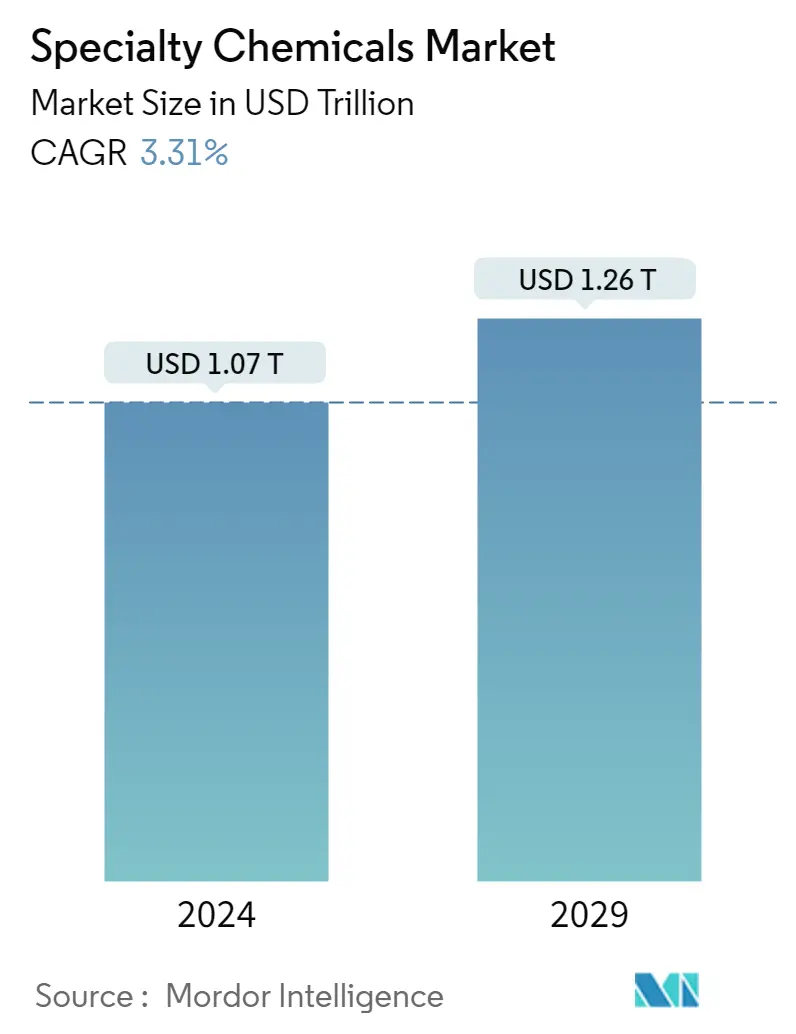
| Study Period | 2019 - 2029 |
| Market Size (2024) | USD 1.07 Trillion |
| Market Size (2029) | USD 1.26 Trillion |
| CAGR (2024 - 2029) | 3.31 % |
| Fastest Growing Market | Asia Pacific |
| Largest Market | Asia Pacific |
Major Players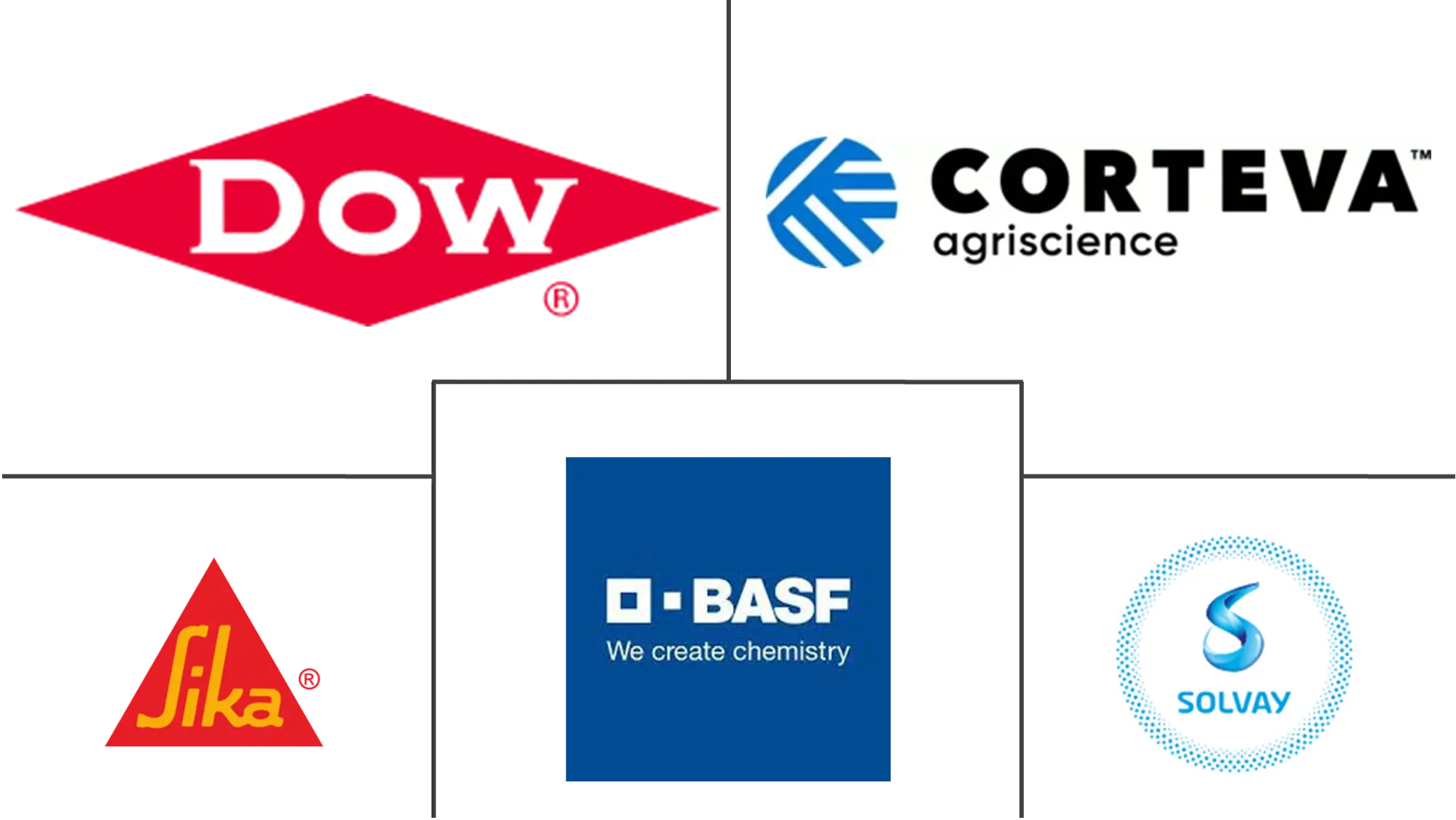
*Disclaimer: Major Players sorted in no particular order |
Speciality Chemicals Market Analysis
The Specialty Chemicals Market size is estimated at USD 1.07 trillion in 2024, and is expected to reach USD 1.26 trillion by 2029, growing at a CAGR of 3.31% during the forecast period (2024-2029).
The market was negatively impacted by the COVID-19 outbreak in 2020. Owing to the pandemic scenario, several countries went into lockdown, which led to supply chain disruptions, work stoppages, and labor shortages. However, the sector is recovering well since restrictions were lifted. An increase in house sales and new project launches have led to a rise in the demand for paints, coatings, and construction chemicals. The increasing demand for semiconductors, integrated circuits, and agrochemicals led to the market recovery over the last two years.
- The major factors driving the market's growth are the robust growth of construction activities, especially in Asia-Pacific and the Middle East & Africa. Furthermore, the growing population is propelling the demand for food worldwide.
- On the flip side, increasing environmental regulations and decreasing fossil fuel reserves are the restraints hampering the market's growth.
- Growing research and development for creating novel products will likely provide an opportunity for the market studied over the forecast period.
- Asia-Pacific dominated the global market, owing to the vast customer base, leading to high demand for specialty chemicals, increasing industrial production, and robust growth of the construction sector in the region.
Speciality Chemicals Market Trends
Agrochemicals Segment to Dominate the Market Demand
- The agrochemicals segment dominated the share in the specialty chemicals market. The segment's growth is extensively driven by the decreasing per capita arable land and increasing demand for food worldwide.
- The global population is increasing rapidly. This growing population is adding to the food demand. Supplying food to this ever-increasing population is becoming a threat. On the other hand, arable land is declining due to industrialization and urbanization. Fertilizers have been used for a long time to increase crop productivity, thus, enhancing agrochemicals demand over the forecast period.
- With the increasing per capita income and growing population, food and cash crops demand is estimated to increase globally. For instance, as per the FAO, the food demand in the United States is expected to increase by 50-90% by 2050.
- The Food and Agriculture Organization of the United Nations (FAO) and the International Food Policy Research Institute (IFPRI) have published projections of an increase in global food demand by 2050. The FAO projections indicate that world food demand may increase by 70% by 2050, with much of the projected increase in global food demand expected to come from rising consumer incomes in Asia-Pacific, Eastern Europe, and Latin America.
- Furthermore, owing to the growing concerns about nutrient efficiency uptake by plants and the growing regulatory health and environmental concerns, micronutrient fertilizers, bio-based fertilizers, and specialty fertilizers (like liquid fertilizers) are gaining popularity.
- Bio-herbicides that use microbes as biological weed control agents are also gaining popularity in integrated pest management techniques, along with synthetic herbicides. Although the segment constitutes only a tiny part of the industry, it is expected to grow significantly.
- Fertilizers exported by all countries totaled around USD 83.2 billion in 2021. That dollar amount reflects an average 50.7%5 increase for all shippers of fertilizers in 2020 when overall fertilizer exports were worth USD 55.2 billion.
- Russia exported USD 12.4 billion in 2021, an increase of around 78% compared to 2020 (USD 6.99 billion), with India being one of the largest importers from the Federation. Additionally, China experienced a significant increase in exports of almost 74.6%. Fertilizer exports from China totaled 11.47 billion USD in 2021.
- Moreover, contracting agricultural land and losing crops owing to pests and diseases are the significant factors driving the insecticide market.
- Hence, all such favorable trends are expected to drive the demand for the agrochemicals market during the forecast period. It is expected to drive the need for specialty chemicals.
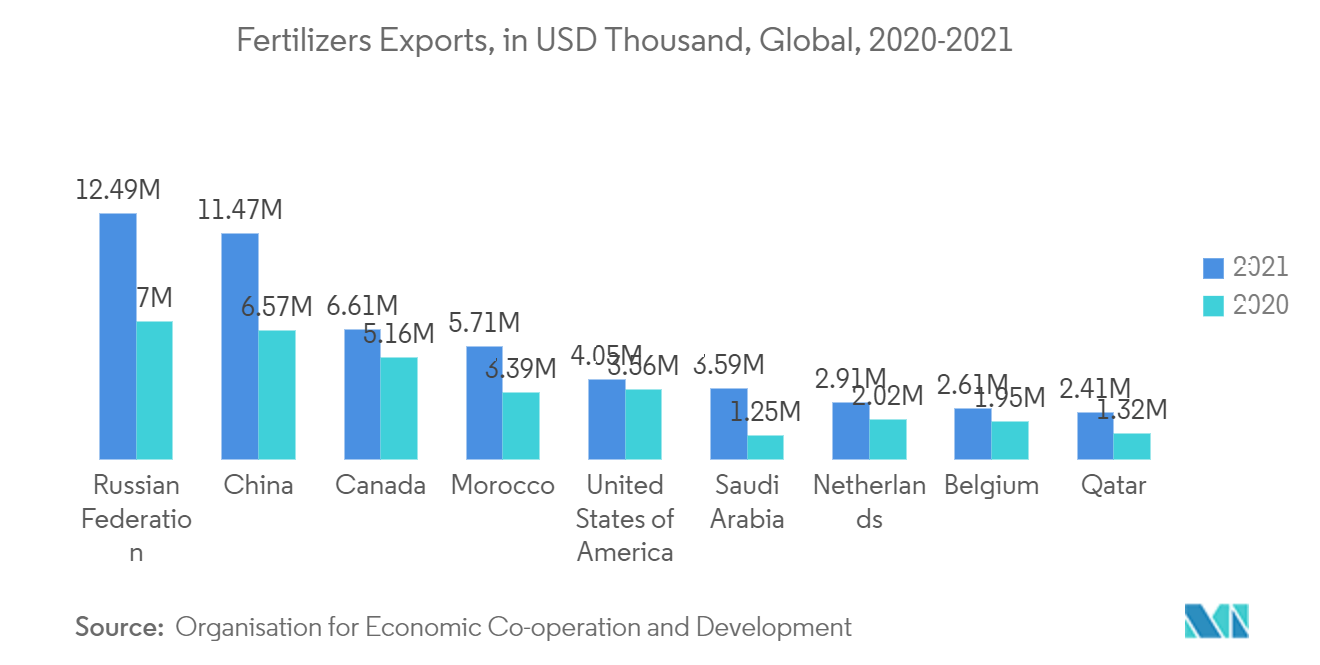
Asia-Pacific Region to Dominate the Market
- The Asia-Pacific region dominated the specialty chemicals market. It is likely to retain its position during the forecast period due to robust growth of the construction sector, increasing cosmetic products demand, growing investment and production in the increasing electrical and electronics industry output, increasing demand for adhesives and plastics from the packaging industry, and increasing installations of water treatment systems from the industries in the region.
- The growing population in the region, especially in countries such as China and India, is increasing the demand for food. It is expected to drive the agrochemical market and consequently help the specialty polymers market grow over the forecast period.
- The growth of the Asia-Pacific construction sector is majorly driven by the service sector expansion, leading to an increase in the demand for office spaces, an increase in residential construction projects, and an inflow of investments from multinational companies to set up an industrial base in the region. Such factors will likely increase the demand for paints and coatings, adhesives and sealants, construction chemicals, and specialty polymers in the area during the forecast period.
- According to the National Bureau of Statistics of China, in 2021, the value added of construction enterprises in China was CNY 8,013.8 billion (~USD 1151.61 billion), up by 2.15% over the previous year.
- India will also likely witness an investment of around USD 1.3 trillion in housing over the next seven years. The country is expected to see the construction of 60 million new homes. The availability of affordable housing is likely to rise by around 70% by 2025 in India. Besides, the Indian government's 'Housing for All by 2022' is also a significant game-changer for the industry.
- Adhesives have become a prime technology component in automotive applications, continuously replacing traditional bonding or adhesion methods. It is increasing adhesives and sealants production in the region, leading to a rise in demand for cosmetic chemicals.
- According to Japan Automobile Manufacturers Association (JAMA), the country produced 7,846,955 units of passenger cars and light vehicles in 2021.
- The electronics industry uses adhesives for various applications, including conformal coatings, protecting terminal electrodes, and bonding of surface mount devices, among many others. The electronics industry is one of the fastest-growing industries in India. According to the Ministry of Electronics and IT, the industry's market size is INR 4,950-5,000 billion (~ USD 66.95-67.62 billion) as of fiscal 2021.
- Hence, all such favorable trends are collectively likely to drive the growth of the specialty chemicals market in the region during the forecast period.
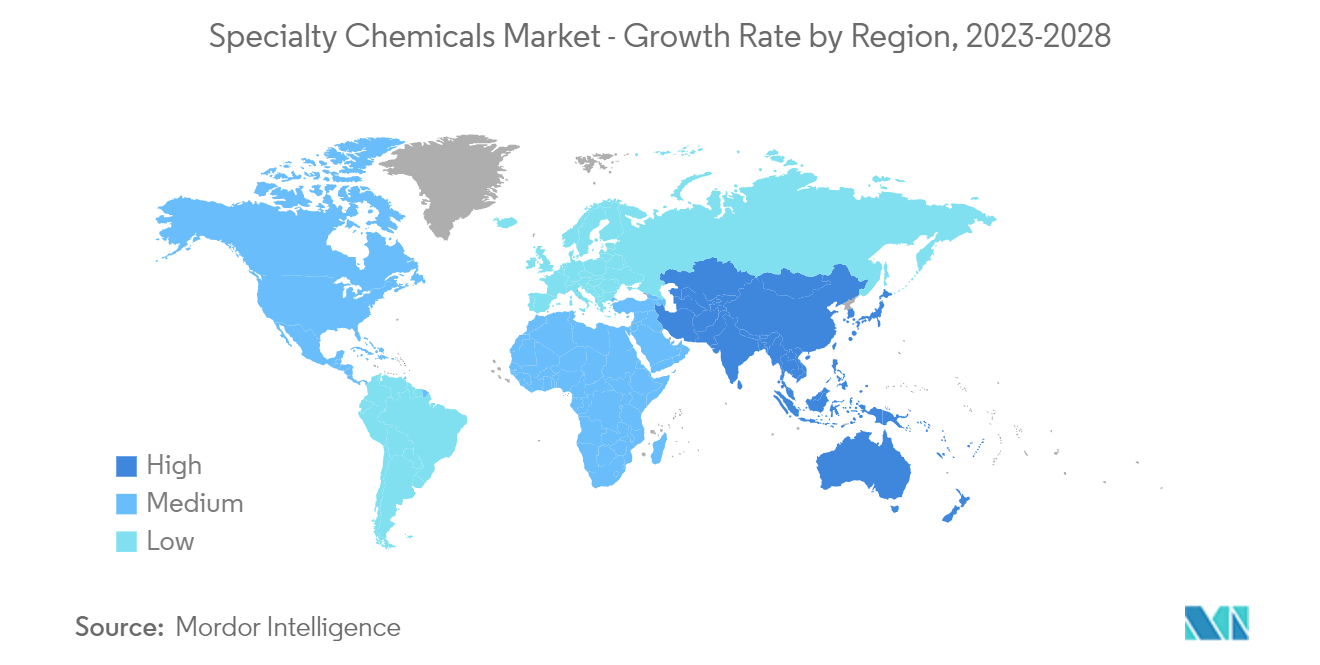
Speciality Chemicals Industry Overview
The specialty chemicals market is highly fragmented, with numerous players holding a significant market share. Some of the major players in the market (in no particular order) include BASF SE, Dow, Corteva, Sika AG, and Solvay, among others.
Speciality Chemicals Market Leaders
-
BASF SE
-
Dow
-
Corteva
-
Sika AG
-
Solvay
*Disclaimer: Major Players sorted in no particular order
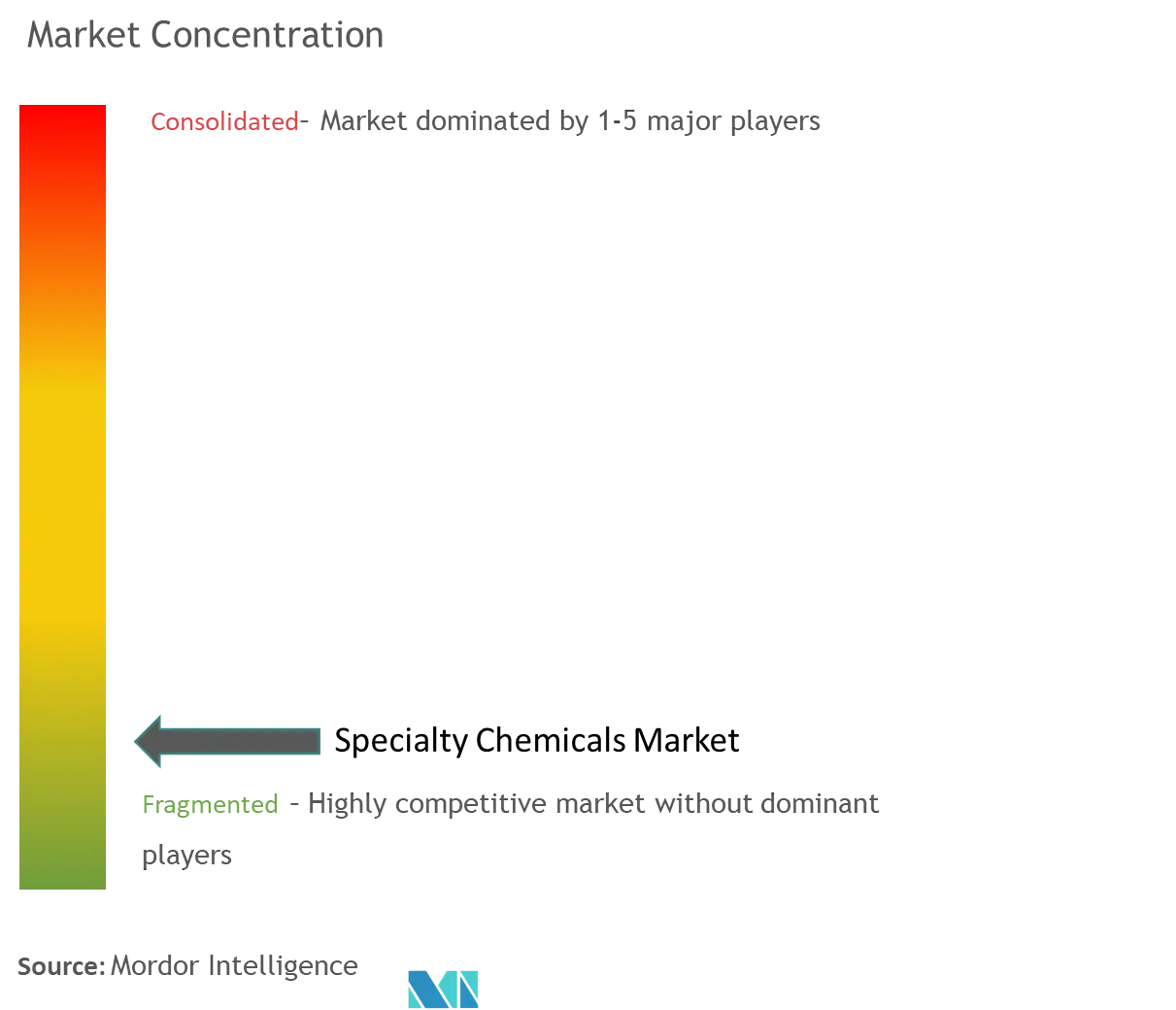
Speciality Chemicals Market News
- December 2022: Clariant AG announced to strengthen its position in China and expand its care chemicals facility in the country, including pharmaceutical, personal care, home care, and industrial applications. The company provides care chemicals under its specialty segment.
- April 2022: Evonik invested in increasing production capacity for isobutene derivatives at its Marl location by 50%5. The isobutene part of the C4 production network produces the petrochemical specialties Tertiary Butanol (TBA), Di- isobutene (DiB), and 3,5,5 Trimethylhexanal (TMH). Tertiary Butanol is a unique solvent and tablet coating for the pharmaceutical industry.
Speciality Chemicals Market Report - Table of Contents
1. INTRODUCTION
- 1.1 Study Assumptions
- 1.2 Scope of the Study
2. RESEARCH METHODOLOGY
3. EXECUTIVE SUMMARY
4. MARKET DYNAMICS
-
4.1 Drivers
- 4.1.1 Robust Growth of Construction Activities in Asia-Pacific, and Middle East and Africa
- 4.1.2 Growing Population is Propelling the Demand for Food Worldwide
-
4.2 Porter's Five Forces Analysis
- 4.2.1 Bargaining Power of Suppliers
- 4.2.2 Bargaining Power of Buyers
- 4.2.3 Threat of New Entrants
- 4.2.4 Threat of Substitute Products and Services
- 4.2.5 Degree of Competition
- 4.3 Raw Material Analysis
5. MARKET SEGMENTATION (Market Size in Value)
-
5.1 Paints and Coatings
- 5.1.1 Dynamics
- 5.1.2 Application
- 5.1.2.1 Architectural
- 5.1.2.2 Automotive
- 5.1.2.3 Industrial
- 5.1.2.4 Wood
- 5.1.2.5 Other Applications
-
5.2 Catalysts
- 5.2.1 Dynamics
- 5.2.2 Function
- 5.2.2.1 Chemical Synthesis Catalysts
- 5.2.2.2 Petroleum Refining Catalysts
- 5.2.2.3 Polymerization Catalysts
-
5.3 Construction Chemicals
- 5.3.1 Dynamics
- 5.3.2 Application
- 5.3.2.1 Commercial
- 5.3.2.2 Industrial
- 5.3.2.3 Infrastructure
- 5.3.2.4 Residential
- 5.3.2.5 Public Space
-
5.4 Cosmetic Chemicals
- 5.4.1 Dynamics
- 5.4.2 Application
- 5.4.2.1 Hair Care
- 5.4.2.2 Skin Care
- 5.4.2.3 Oral Care
- 5.4.2.4 Personal Hygiene
- 5.4.2.5 Other Applications
-
5.5 Dyes, Inks, and Pigments
- 5.5.1 Dynamics
- 5.5.2 Type
- 5.5.2.1 Inks
- 5.5.2.2 Dyes
- 5.5.2.3 Organic Pigments
- 5.5.2.4 Inorganic Pigments
-
5.6 Electronic Chemicals
- 5.6.1 Dynamics
- 5.6.2 Application
- 5.6.2.1 Semiconductors and Integrated Circuits
- 5.6.2.2 Printed Circuit Boards
-
5.7 Water Treatment Chemicals
- 5.7.1 Dynamics
- 5.7.2 Function
- 5.7.2.1 Flocculants
- 5.7.2.2 Coagulants
- 5.7.2.3 Biocides and Disinfectants
- 5.7.2.4 Defoamers and Defoaming Agents
- 5.7.2.5 pH Adjusters and Softeners
- 5.7.2.6 Other Functions
-
5.8 Food Additives
- 5.8.1 Dynamics
- 5.8.2 Type
- 5.8.2.1 Natural Additives
- 5.8.2.2 Synthetic Additives
-
5.9 Agrochemicals
- 5.9.1 Dynamics
- 5.9.2 Type
- 5.9.2.1 Fertilizers
- 5.9.2.2 Herbicide
- 5.9.2.3 Fungicide
- 5.9.2.4 Insecticide
- 5.9.2.5 Nematicide
- 5.9.2.6 Molluscicide
- 5.9.2.7 Other Crop Protection Chemicals
-
5.10 Industrial and Institutional Cleaners
- 5.10.1 Dynamics
- 5.10.2 Application
- 5.10.2.1 General Purpose Cleaners
- 5.10.2.2 Disinfectants and Sanitizers
- 5.10.2.3 Laundry Care Products
- 5.10.2.4 Vehicle Wash Products
-
5.11 Lubricant Additives
- 5.11.1 Dynamics
- 5.11.2 Product Type
- 5.11.2.1 Dispersants and Emulsifiers
- 5.11.2.2 Detergents
- 5.11.2.3 Oxidation Inhibitors
- 5.11.2.4 Extreme-pressure Additives and Anti-wear Additives
- 5.11.2.5 Viscosity Index Modifiers
- 5.11.2.6 Friction Modifiers
- 5.11.2.7 Corrosion Inhibitors
- 5.11.2.8 Other Product Types
-
5.12 Mining Chemicals
- 5.12.1 Dynamics
- 5.12.2 Function
- 5.12.2.1 Flotation Chemicals
- 5.12.2.2 Extraction Chemicals
- 5.12.2.3 Grinding Aids
-
5.13 Oilfield Chemicals
- 5.13.1 Dynamics
- 5.13.2 Application
- 5.13.2.1 Biocide
- 5.13.2.2 Corrosion and Scale Inhibitor
- 5.13.2.3 Demulsifier
- 5.13.2.4 Polymer
- 5.13.2.5 Surfactant
- 5.13.2.6 Other Chemical Types
-
5.14 Adhesives and Sealants
- 5.14.1 Dynamics
- 5.14.2 Technology
- 5.14.2.1 Water-borne Adhesives
- 5.14.2.2 Solvent-borne Adhesives
- 5.14.2.3 Hot-melt Adhesives
- 5.14.2.4 Reactive Adhesives
- 5.14.2.5 Other Adhesives
- 5.14.2.6 Sealants
-
5.15 Plastic Additives
- 5.15.1 Dynamics
- 5.15.2 Plastic Type
- 5.15.2.1 Polyethylene (PE)
- 5.15.2.2 Polystyrene (PS)
- 5.15.2.3 Polypropylene (PP)
- 5.15.2.4 Polyamide (PA)
- 5.15.2.5 Polyethylene Terephthalate (PET)
- 5.15.2.6 Polyvinyl Chloride (PVC)
- 5.15.2.7 Polycarbonate (PC)
- 5.15.2.8 Other Plastic Types
-
5.16 Rubber Processing Chemicals
- 5.16.1 Dynamics
- 5.16.2 Application
- 5.16.2.1 Tire
- 5.16.2.2 Non-tire
-
5.17 Specialty Polymers
- 5.17.1 Dynamics
-
5.18 Textile Chemicals
- 5.18.1 Dynamics
- 5.18.2 Application
- 5.18.2.1 Coating and Sizing Chemicals
- 5.18.2.2 Colorants and Auxiliaries
- 5.18.2.3 Finishing Agents
- 5.18.2.4 Desizing Agents
- 5.18.2.5 Other Application
-
5.19 Geography
- 5.19.1 Asia-Pacific
- 5.19.1.1 China
- 5.19.1.2 India
- 5.19.1.3 Japan
- 5.19.1.4 South Korea
- 5.19.1.5 ASEAN Countries
- 5.19.1.6 Rest of Asia-Pacific
- 5.19.2 North America
- 5.19.2.1 United States
- 5.19.2.2 Canada
- 5.19.2.3 Mexico
- 5.19.2.4 Rest of North America
- 5.19.3 Europe
- 5.19.3.1 Germany
- 5.19.3.2 United Kingdom
- 5.19.3.3 Italy
- 5.19.3.4 France
- 5.19.3.5 Spain
- 5.19.3.6 Rest of Europe
- 5.19.4 South America
- 5.19.4.1 Brazil
- 5.19.4.2 Argentina
- 5.19.4.3 Rest of South America
- 5.19.5 Middle-East and Africa
- 5.19.5.1 Saudi Arabia
- 5.19.5.2 South Africa
- 5.19.5.3 Rest of Middle-East and Africa
6. COMPETITIVE LANDSCAPE
- 6.1 Mergers and Acquisitions, Joint Ventures, Collaborations, and Agreements
-
6.2 Market Share Analysis
- 6.2.1 Adhesives and Sealants
- 6.2.2 Agrochemicals
- 6.2.3 Construction Chemicals
- 6.2.4 Lubricants and Oil Additives
- 6.2.5 Mining Chemicals
- 6.2.6 Oilfield Chemicals
- 6.2.7 Paints and Coatings
- 6.2.8 Specialty Polymers
- 6.2.9 Water Treatment Chemicals
- 6.3 Strategies Adopted by Leading Players
-
6.4 Company Profiles
- 6.4.1 3M
- 6.4.2 AECI
- 6.4.3 Afton Chemical
- 6.4.4 Akzo Nobel NV
- 6.4.5 Albemarle Corporation
- 6.4.6 ALTANA
- 6.4.7 Archroma
- 6.4.8 Arkema Group
- 6.4.9 Ashland
- 6.4.10 Asian Paints
- 6.4.11 Axalta Coating Systems
- 6.4.12 Baker Hughes Company
- 6.4.13 BASF SE
- 6.4.14 Berger Paints India Limited
- 6.4.15 Buckman
- 6.4.16 Chevron Corporation
- 6.4.17 Clariant
- 6.4.18 Corteva
- 6.4.19 Covestro AG
- 6.4.20 DIC Corporation
- 6.4.21 Dow
- 6.4.22 DSM
- 6.4.23 DuPont
- 6.4.24 Eastman Chemical Company
- 6.4.25 Ecolab
- 6.4.26 Evonik Industries AG
- 6.4.27 Exxon Mobil Corporation
- 6.4.28 Ferro Corporation
- 6.4.29 Flint Group
- 6.4.30 FMC Corporation
- 6.4.31 GCP Applied Technologies Inc.
- 6.4.32 H.B. Fuller Company
- 6.4.33 Halliburton
- 6.4.34 Henkel AG & Co. KGaA
- 6.4.35 Hexcel Corporation
- 6.4.36 Huntsman International LLC
- 6.4.37 Infineum International Limited
- 6.4.38 Kemira
- 6.4.39 KRONOS Worldwide Inc.
- 6.4.40 Kurita Water Industries Ltd
- 6.4.41 Holcim
- 6.4.42 LANXESS
- 6.4.43 Lonza
- 6.4.44 MAPEI SpA
- 6.4.45 Merck KGaA
- 6.4.46 NIPSEA GROUP
- 6.4.47 Nouryon
- 6.4.48 Nutrien Ltd
- 6.4.49 Pidilite Industries Ltd
- 6.4.50 PPG Industries Inc.
- 6.4.51 Procter & Gamble
- 6.4.52 RPM International Inc.
- 6.4.53 SABIC
- 6.4.54 Schlumberger Limited
- 6.4.55 Sika AG
- 6.4.56 Solenis
- 6.4.57 Solvay
- 6.4.58 Syngenta
- 6.4.59 The Chemours Company
- 6.4.60 The Lubrizol Corporation
- 6.4.61 The Sherwin-Williams Company
- 6.4.62 Venator Materials PLC
- 6.4.63 Veolia
- 6.4.64 W. R. Grace & Co.
- 6.4.65 Wacker Chemie AG
- 6.4.66 Yara
- *List Not Exhaustive
7. MARKET OPPORTUNITIES AND FUTURE TRENDS
** Subject To AvailablitySpeciality Chemicals Industry Segmentation
Specialty chemicals are the chemical products on which many other industries, such as construction chemicals, paints and coatings, textile chemicals, mining chemicals, plastic additives, and others, rely. The applications of specialty chemicals include boosting agricultural, construction, pharmaceutical products processing, chemical and intermediates processing, food processing and ingredients for household, coatings and paper trading, and transportation. The Specialty Chemicals Market is segmented by paints and coatings (dynamics, application (architectural, automotive, industrial, wood, and other applications)), catalysts (dynamics, function (chemical synthesis catalysts, petroleum refining catalysts, and polymerization catalysts)), construction chemicals (dynamics, application (commercial, industrial, infrastructure, residential, and public space)), cosmetic chemicals (dynamics, application (hair care, skin care, oral care, personal hygiene and other applications)), dyes, inks, and pigments (dynamics, type (inks, dyes, organic pigments and inorganic pigments)), electronic chemicals (dynamics, application (semiconductor and integrated circuits, and printed circuit boards)), water treatment chemicals (dynamics, function (flocculants, coagulants, biocides and disinfectants, defoamers and defoaming agents, pH adjusters and softeners, and other functions)), food additives (dynamics, type (natural additives, and synthetic additives)), agrochemicals (dynamics, type (fertilizers, herbicide, fungicide, insecticide, nematicide, molluscicide, and other crop protection chemicals)), industrial and institutional cleaners (dynamics, application (general purpose cleaners, disinfectants and sanitizers, laundry care products, and vehicle wash products)), lubricant additives (dynamics, product type (dispersants and emulsifiers, detergents, oxidation inhibitors, extreme-pressure additives and anti-wear additives, viscosity index modifiers, friction modifiers, corrosion inhibitors, and other product types)), mining chemicals (dynamics, function (flotation chemicals, extraction chemicals, and grinding aids)), oilfield chemicals (dynamics, application (biocide, corrosion and scale inhibitor, demulsifier, polymer, surfactant, and other chemical types)), adhesives and sealants (dynamics, technology (water-borne adhesives, solvent-borne adhesives, hot-melt adhesives, reactive adhesives, other adhesives, and sealants)), plastic additives (dynamics, plastic-type (Polyethylene (PE), Polystyrene (PS), Polypropylene (PP), Polyamide (PA), Polyethylene Terephthalate (PET), Polyvinyl Chloride (PVC), Polycarbonate (PC), and other plastic types)), rubber processing chemicals (dynamics, application (tire, and non-tire)), specialty polymers (dynamics), textile chemicals (dynamics, application (Coating and Sizing Chemicals, Colorants and Auxiliaries, Finishing Agents, Desizing Agents, and other application)) and geography (Asia-Pacific, North America, Europe, South America, and Middle-East and Africa). The report offers market size and forecasts for Specialty Chemicals in revenue (USD million) for all the above segments.
| Paints and Coatings | Dynamics | |
| Application | Architectural | |
| Automotive | ||
| Industrial | ||
| Wood | ||
| Other Applications | ||
| Catalysts | Dynamics | |
| Function | Chemical Synthesis Catalysts | |
| Petroleum Refining Catalysts | ||
| Polymerization Catalysts | ||
| Construction Chemicals | Dynamics | |
| Application | Commercial | |
| Industrial | ||
| Infrastructure | ||
| Residential | ||
| Public Space | ||
| Cosmetic Chemicals | Dynamics | |
| Application | Hair Care | |
| Skin Care | ||
| Oral Care | ||
| Personal Hygiene | ||
| Other Applications | ||
| Dyes, Inks, and Pigments | Dynamics | |
| Type | Inks | |
| Dyes | ||
| Organic Pigments | ||
| Inorganic Pigments | ||
| Electronic Chemicals | Dynamics | |
| Application | Semiconductors and Integrated Circuits | |
| Printed Circuit Boards | ||
| Water Treatment Chemicals | Dynamics | |
| Function | Flocculants | |
| Coagulants | ||
| Biocides and Disinfectants | ||
| Defoamers and Defoaming Agents | ||
| pH Adjusters and Softeners | ||
| Other Functions | ||
| Food Additives | Dynamics | |
| Type | Natural Additives | |
| Synthetic Additives | ||
| Agrochemicals | Dynamics | |
| Type | Fertilizers | |
| Herbicide | ||
| Fungicide | ||
| Insecticide | ||
| Nematicide | ||
| Molluscicide | ||
| Other Crop Protection Chemicals | ||
| Industrial and Institutional Cleaners | Dynamics | |
| Application | General Purpose Cleaners | |
| Disinfectants and Sanitizers | ||
| Laundry Care Products | ||
| Vehicle Wash Products | ||
| Lubricant Additives | Dynamics | |
| Product Type | Dispersants and Emulsifiers | |
| Detergents | ||
| Oxidation Inhibitors | ||
| Extreme-pressure Additives and Anti-wear Additives | ||
| Viscosity Index Modifiers | ||
| Friction Modifiers | ||
| Corrosion Inhibitors | ||
| Other Product Types | ||
| Mining Chemicals | Dynamics | |
| Function | Flotation Chemicals | |
| Extraction Chemicals | ||
| Grinding Aids | ||
| Oilfield Chemicals | Dynamics | |
| Application | Biocide | |
| Corrosion and Scale Inhibitor | ||
| Demulsifier | ||
| Polymer | ||
| Surfactant | ||
| Other Chemical Types | ||
| Adhesives and Sealants | Dynamics | |
| Technology | Water-borne Adhesives | |
| Solvent-borne Adhesives | ||
| Hot-melt Adhesives | ||
| Reactive Adhesives | ||
| Other Adhesives | ||
| Sealants | ||
| Plastic Additives | Dynamics | |
| Plastic Type | Polyethylene (PE) | |
| Polystyrene (PS) | ||
| Polypropylene (PP) | ||
| Polyamide (PA) | ||
| Polyethylene Terephthalate (PET) | ||
| Polyvinyl Chloride (PVC) | ||
| Polycarbonate (PC) | ||
| Other Plastic Types | ||
| Rubber Processing Chemicals | Dynamics | |
| Application | Tire | |
| Non-tire | ||
| Specialty Polymers | Dynamics | |
| Textile Chemicals | Dynamics | |
| Application | Coating and Sizing Chemicals | |
| Colorants and Auxiliaries | ||
| Finishing Agents | ||
| Desizing Agents | ||
| Other Application | ||
| Geography | Asia-Pacific | China |
| India | ||
| Japan | ||
| South Korea | ||
| ASEAN Countries | ||
| Rest of Asia-Pacific | ||
| Geography | North America | United States |
| Canada | ||
| Mexico | ||
| Rest of North America | ||
| Geography | Europe | Germany |
| United Kingdom | ||
| Italy | ||
| France | ||
| Spain | ||
| Rest of Europe | ||
| Geography | South America | Brazil |
| Argentina | ||
| Rest of South America | ||
| Geography | Middle-East and Africa | Saudi Arabia |
| South Africa | ||
| Rest of Middle-East and Africa |
Speciality Chemicals Market Research FAQs
How big is the Specialty Chemicals Market?
The Specialty Chemicals Market size is expected to reach USD 1.07 trillion in 2024 and grow at a CAGR of 3.31% to reach USD 1.26 trillion by 2029.
What is the current Specialty Chemicals Market size?
In 2024, the Specialty Chemicals Market size is expected to reach USD 1.07 trillion.
Who are the key players in Specialty Chemicals Market?
BASF SE, Dow, Corteva, Sika AG and Solvay are the major companies operating in the Specialty Chemicals Market.
Which is the fastest growing region in Specialty Chemicals Market?
Asia Pacific is estimated to grow at the highest CAGR over the forecast period (2024-2029).
Which region has the biggest share in Specialty Chemicals Market?
In 2024, the Asia Pacific accounts for the largest market share in Specialty Chemicals Market.
What years does this Specialty Chemicals Market cover, and what was the market size in 2023?
In 2023, the Specialty Chemicals Market size was estimated at USD 1.04 trillion. The report covers the Specialty Chemicals Market historical market size for years: 2019, 2020, 2021, 2022 and 2023. The report also forecasts the Specialty Chemicals Market size for years: 2024, 2025, 2026, 2027, 2028 and 2029.
What are the growth prospects for the Specialty Chemicals Market?
The growth prospects for the Specialty Chemicals Market are a) Increasing demand from end-use industries such as automotive, electronics, construction, medical, and packaging b) Emerging trends such as green and sustainable specialty chemicals
Speciality Chemicals Industry Report
The specialty chemicals industry is experiencing robust growth, driven by increasing demand from key sectors such as automotive, electronics, construction, medical, and packaging. This market, rich in diversity, spans products like plastic additives, rubber additives, adhesives, and more, with plasticizers and consumer goods standing out as significant segments. The Asia Pacific region, fueled by industrialization, urbanization, and rising incomes, leads the charge, moving towards green and sustainable specialty chemicals despite challenges like raw material price volatility and stringent regulations. Leading specialty chemical companies are focusing on innovation and sustainability to stay competitive, with forecasts indicating a continued shift towards eco-friendly solutions.
The industry reports provide a comprehensive industry analysis and industry outlook, detailing the market growth and market trends. These industry reports offer valuable market data, market segmentation, and market predictions that are crucial for understanding the industry size and market value. The market overview and market review sections highlight the market leaders and their strategies, while the market forecast gives insights into future market trends.
For in-depth industry information and research, industry research reports cover various segments including paints and coatings, catalysts, construction chemicals, cosmetic chemicals, dyes, inks, and pigments, electronic chemicals, water treatment chemicals, food additives, agrochemicals, industrial and institutional cleaners, lubricant additives, mining chemicals, oilfield chemicals, adhesives and sealants, plastic additives, rubber processing chemicals, specialty polymers, and textile chemicals. The industry statistics provided help in understanding the market outlook and market growth, ensuring that stakeholders are well-informed about the market dynamics.
These reports are available for download in report pdf format, offering detailed sector analysis and market research. The industry sales data included in these reports highlight the market cap and market share of leading companies, providing a clear picture of the competitive landscape. For those looking for a report example or detailed industry research, these reports are an invaluable resource.



